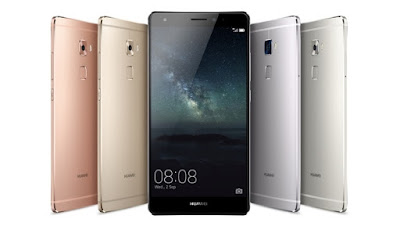BERLIN—When you play at this level, there's no ordinary venue. Huawei rented out a gigantic hall here at IFA to debut its new Mate S smartphone, throwing a runway show and commissioning a pop song for the occasion. Luckily, the phones don't seem to disappoint.
The Mate S, Huawei's new flagship, borrows many of its competitors' flagship features and then mixes in a bunch of Huawei's own unique capabilities. I don't want to call this copying since everybody copies; this is Huawei embracing, extending, and adding to the high-end smartphone landscape.
The Mate S is a slim phone with a bowed metal back. It definitely shares some design cues with the iPhone, but it's more rectangular all around, with less of a bezel; it's between the size of the iPhone 6 and the 6 Plus (or between the Samsung Galaxy S6 and Note 5, as the case may be.) There's a 5.5-inch, 1080p LCD screen that basically waterfalls over the side a little in what Huawei calls "2.5d glass," but it isn't an effect you really notice. The matte metal back isn't slippery, and has a 13-megapixel camera on a slight hump and the fingerprint sensor. You can choose between socking in two SIM cards or using one of the slots for a MicroSD card.
The Mate S runs Android 5.1.1, but it's Android with Huawei's EMUI, which means a ton of changes, most disturbingly no app tray. (All your apps have to go on the home screens.) There's a new Hisilicon Kirin 935 processor in here which has Snapdragon 808-like benchmarks: it got about 50,000 on Antutu, similar to the LG G4 and ZTE Axon, although its Geekbench scores performed more like a Snapdragon 810. In any case, it's a good processor, but it doesn't dethrone the Samsung Exynos 7250 as the fastest Android device in the land.
On the camera front, there's a 13-megapixel main camera with surprisingly good low-light performance, but the real news to me is that the 8-megapixel front-facing camera has a "selfie light." The light is like a dim flash designed for selfies, and it works best if you hold the phone at full arms' length. I tried it in a dim bathroom, and it definitely lit things up. With the phone closer to my face, though, my face was pretty blown out.
Huawei says it has amped up the fingerprint sensor, making it twice as accurate and twice as fast as on previous phones, and I'm happy to say that appears to be the case. I set a fingerprint lock on a Mate S, and had no problem nine out of 10 times. Excitingly, my fingerprint also unlocked the phone from its off state, so there was no two-step process of waking up the phone. You can also use the fingerprint sensor to take photos (useful for selfies) or dismiss notifications. It worked fine.
The phone also supposedly supports force touch, where pressing hard on the screen performs actions like zooming in on photos. The phone even works as a small kitchen scale: put an object on the screen (don't worry, the Mate S is waterproof), and it'll tell you how much it weighs. Unfortunately, I couldn't make the feature work at all; pressing hard on the screen didn't do anything different from pressing the normal amount.
There's more, too. I was very impressed by how much work Huawei put into reception and voice quality, with a tunable radio (for more on that, see below) and a way to use the phone's three microphones directionally, to reject sound that isn't coming from people you want to be listening to. Qualcomm talked about that a lot with the Snapdragon 810, but we didn't end up seeing that feature on any retail devices.
Could we consider force touch borrowed from Apple? Could we consider it borrowed from BlackBerry, which really debuted the feature on the BlackBerry Storm? Could we consider the Mate S's ability to launch apps by drawing on the screen borrowed from Asus? Is its long-screen-capture mode ripped off from Samsung? No, no, no—even though Huawei insisted on comparing its design to the iPhone's over and over again, everybody learns from each other, as everybody should. Maybe Motorola's next phone will work as a kitchen scale. The Moto X Styleis certainly big enough.
The Mate S will sell for more than $700, and Huawei does not currently have plans to bring it to the U.S., even though it will apparently work here. But wait ...
Is It the Nexus?
Most people expect either the Mate S or Huawei's previous phone, the P8, to be the hardware basis for Google's next Nexus 6. There's no real way this phone could be called a six-incher, and force touch is nowhere in Android, so I'm feeling a little skeptical. But there's one feature in this and the P8 that definitely makes me think of the Nexus: an option to "intelligently choose between Wi-Fi and mobile data," and another option to change the phone's rules about handoffs between cell towers.
In normal life, that will just make for a phone with excellent reception, which is great. But these features are also critical to making Google's Project Fi service work, which only runs on Nexus devices. So, there's that.
Source: pcmag.com


0 comments:
Post a Comment